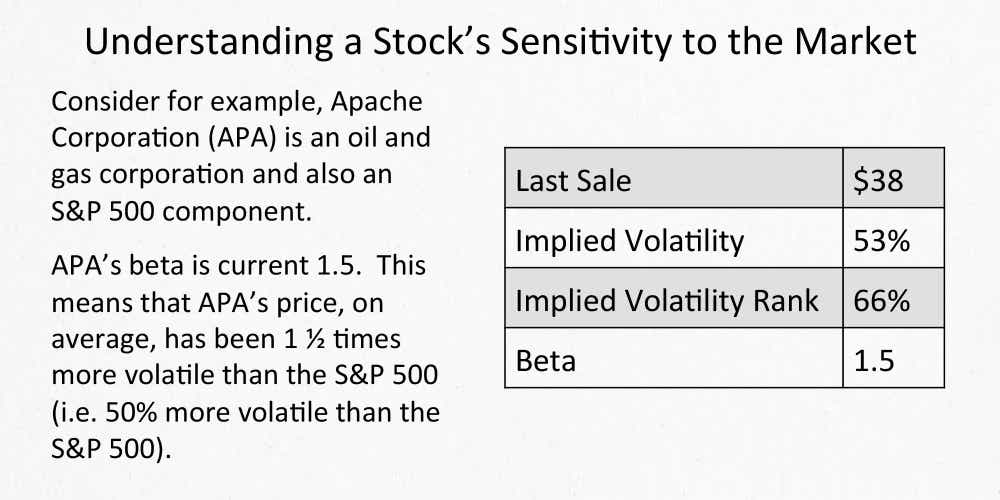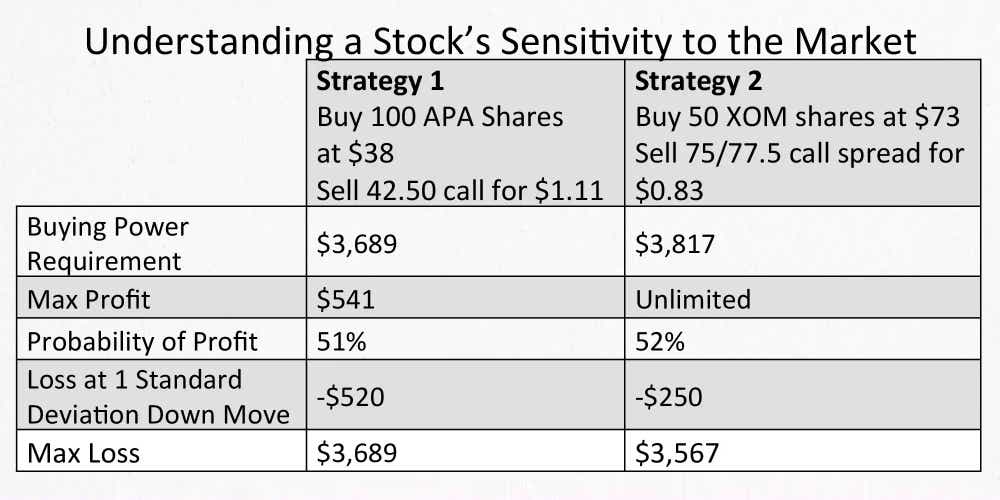High Beta vs Low Beta: Key Similarities and Differences

High Beta vs Low Beta: Key Similarities and Differences
Adding a little extra beta to an account can seem like a good idea during bull markets. However, as markets become more volatile, that extra beta can act like a heavy anchor in a rough storm.
In trading, beta is the volatility measure of a security or a portfolio in comparison to the market as a whole. By definition, the market itself has a beta of 1.0, and individual stocks are ranked according to how much they deviate from the macro market. High-beta stocks (>1.0) are supposed to be riskier but provide the potential for higher returns; low-beta stocks (<1.0) pose less risk but also lower returns.
For example, if stock XYZ has a beta of 1.5, then we would expect XYZ to move, on average, 50% more than the market. So if the S&P moves up/down 1%, we would expect to see XYZ move up/down 1.5%.
Recent volatile market conditions have led to institutional and individual investors shifting positions away from higher beta stocks to lower beta stocks to help reduce their portfolio's sensitivity to overall market movements.
In an episode of Closing the Gap, the guys examine some examples of how traders can transfer risk from high beta positions to lower beta positions. With oil prices under pressure in recent months, the energy sector represents an excellent area where a trader might want to reduce overall beta.
On the show, the hosts introduce the stocks Apache (APA) and Exxon (XOM) to help illustrate the best approach to risk reduction in terms of beta exposure.
The graphic below depicts some of the current trading information for APA, including beta:

What if a trader has a bullish sentiment in APA, but is concerned with the high beta (i.e. volatility) of the stock?
One possible solution is to consider XOM, with a more moderate beta of 1, as a possible vehicle for the same type of trade. APA has roughly a 0.70 correlation to XOM, meaning that movement between the two is historically correlated to a fairly high degree.
So the question then is how a trader can express his market view in XOM, as opposed to APA? It's important to note that XOM trades at a much higher price than APA ($73 vs. $38), which will affect how we scale the trade.
While a trader may have been looking to execute a covered call in APA, that same strategy is not available for the same amount of capital outlay in XOM (due to the higher stock price). In this instance, a trader could instead consider selling a call spread in XOM, which would require less capital but closely mimic the risk profile of the covered call in APA.
The slide below highlights the details of each potential trade:

We see above that the XOM trade not only experiences less drawdown on a one standard deviation move down, but it also has lower maximum loss and greater potential profit.
Having traded many such positions during the financial crisis starting in 2007, lower beta names (which also tend to be companies with larger market capitalization) experienced significantly less volatility than high beta (low capitalization) companies during those violent swings in the market.
Trading in low beta names vs. high beta names better protects your portfolio from drawdowns in capital and spares you from exposure to the emotional roller coaster ride that is often associated with volatile stocks in jagged moving markets.
In times of crisis, low capitalization (generally higher beta) names also have more bankruptcy risk. While we don't know how the current spiral in oil prices will ultimately affect the energy industry, it seems fairly likely that more than a few industry participants won't make it through intact - especially in the high beta category.
Don't hesitate to contact us with any feedback or questions at support@tastylive.com.
Happy Trading!
Sage Anderson has an extensive background trading equity derivatives and managing volatility-based portfolios. He has traded hundreds of thousands of contracts across the spectrum of industries in the single-stock universe.
Options involve risk and are not suitable for all investors. Please read Characteristics and Risks of Standardized Options before deciding to invest in options.
tastylive content is created, produced, and provided solely by tastylive, Inc. (“tastylive”) and is for informational and educational purposes only. It is not, nor is it intended to be, trading or investment advice or a recommendation that any security, futures contract, digital asset, other product, transaction, or investment strategy is suitable for any person. Trading securities, futures products, and digital assets involve risk and may result in a loss greater than the original amount invested. tastylive, through its content, financial programming or otherwise, does not provide investment or financial advice or make investment recommendations. Investment information provided may not be appropriate for all investors and is provided without respect to individual investor financial sophistication, financial situation, investing time horizon or risk tolerance. tastylive is not in the business of transacting securities trades, nor does it direct client commodity accounts or give commodity trading advice tailored to any particular client’s situation or investment objectives. Supporting documentation for any claims (including claims made on behalf of options programs), comparisons, statistics, or other technical data, if applicable, will be supplied upon request. tastylive is not a licensed financial adviser, registered investment adviser, or a registered broker-dealer. Options, futures, and futures options are not suitable for all investors. Prior to trading securities, options, futures, or futures options, please read the applicable risk disclosures, including, but not limited to, the Characteristics and Risks of Standardized Options Disclosure and the Futures and Exchange-Traded Options Risk Disclosure found on tastytrade.com/disclosures.
tastytrade, Inc. ("tastytrade”) is a registered broker-dealer and member of FINRA, NFA, and SIPC. tastytrade was previously known as tastyworks, Inc. (“tastyworks”). tastytrade offers self-directed brokerage accounts to its customers. tastytrade does not give financial or trading advice, nor does it make investment recommendations. You alone are responsible for making your investment and trading decisions and for evaluating the merits and risks associated with the use of tastytrade’s systems, services or products. tastytrade is a wholly-owned subsidiary of tastylive, Inc.
tastytrade has entered into a Marketing Agreement with tastylive (“Marketing Agent”) whereby tastytrade pays compensation to Marketing Agent to recommend tastytrade’s brokerage services. The existence of this Marketing Agreement should not be deemed as an endorsement or recommendation of Marketing Agent by tastytrade. tastytrade and Marketing Agent are separate entities with their own products and services. tastylive is the parent company of tastytrade.
tastyfx, LLC (“tastyfx”) is a Commodity Futures Trading Commission (“CFTC”) registered Retail Foreign Exchange Dealer (RFED) and Introducing Broker (IB) and Forex Dealer Member (FDM) of the National Futures Association (“NFA”) (NFA ID 0509630). Leveraged trading in foreign currency or off-exchange products on margin carries significant risk and may not be suitable for all investors. We advise you to carefully consider whether trading is appropriate for you based on your personal circumstances as you may lose more than you invest.
tastycrypto is provided solely by tasty Software Solutions, LLC. tasty Software Solutions, LLC is a separate but affiliate company of tastylive, Inc. Neither tastylive nor any of its affiliates are responsible for the products or services provided by tasty Software Solutions, LLC. Cryptocurrency trading is not suitable for all investors due to the number of risks involved. The value of any cryptocurrency, including digital assets pegged to fiat currency, commodities, or any other asset, may go to zero.
© copyright 2013 - 2025 tastylive, Inc. All Rights Reserved. Applicable portions of the Terms of Use on tastylive.com apply. Reproduction, adaptation, distribution, public display, exhibition for profit, or storage in any electronic storage media in whole or in part is prohibited under penalty of law, provided that you may download tastylive’s podcasts as necessary to view for personal use. tastylive was previously known as tastytrade, Inc. tastylive is a trademark/servicemark owned by tastylive, Inc.